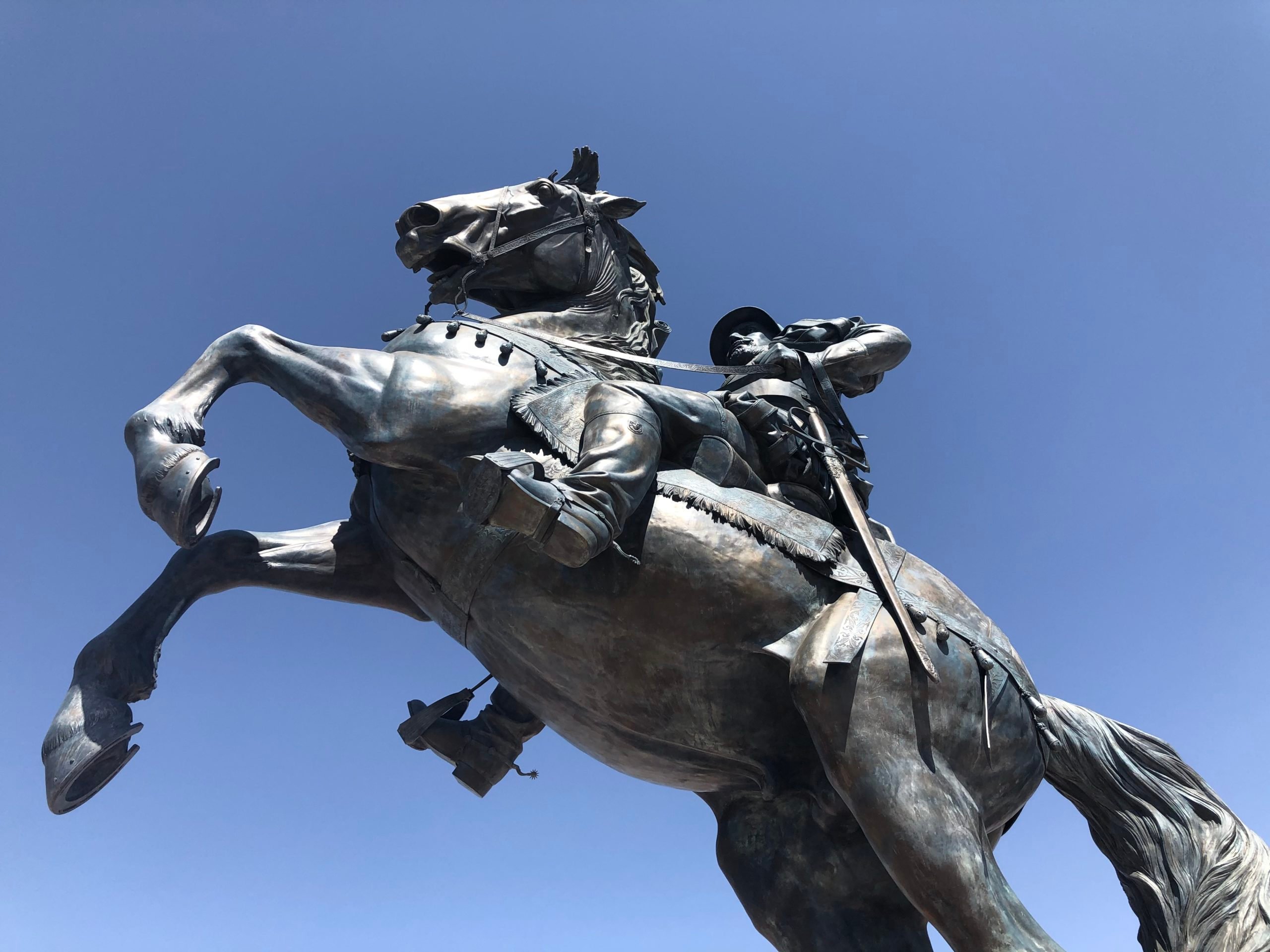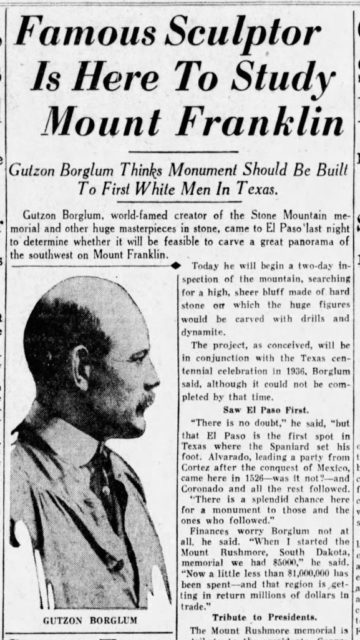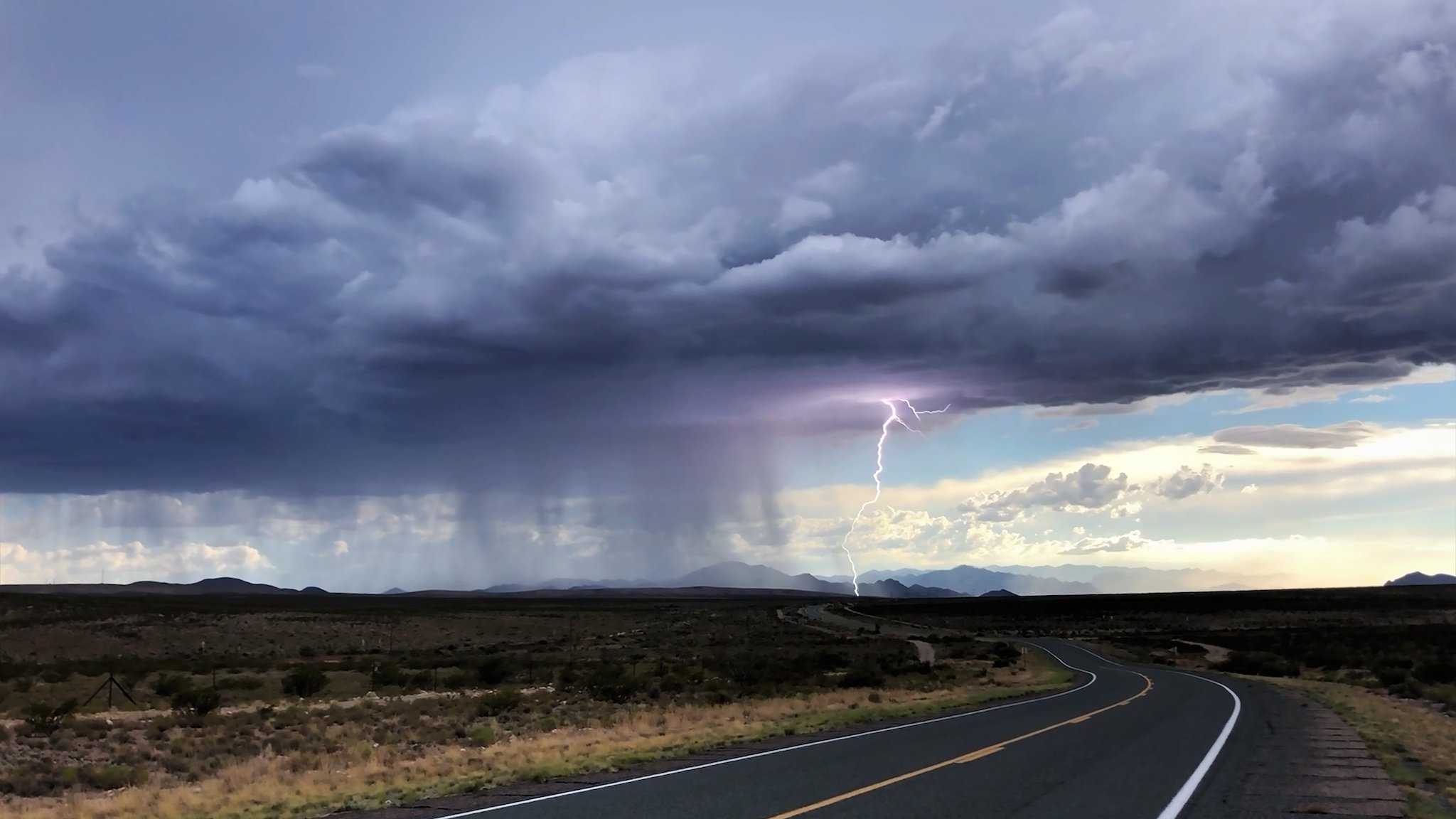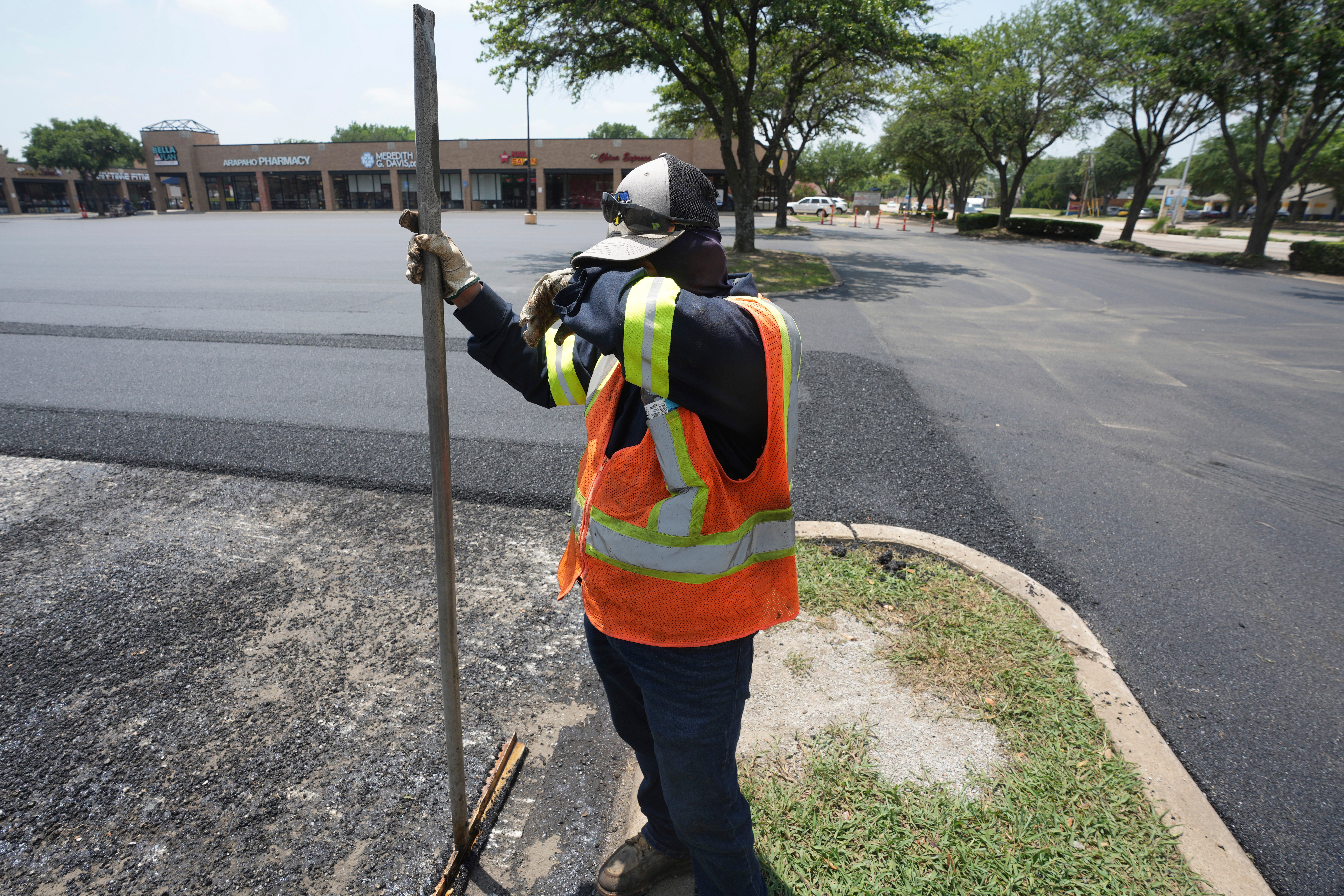
The Racist History Behind El Paso’s XII Travelers Memorial
Protesters in El Paso have focused on toppling the Equestrian, a monument to a racist colonizer. But the story behind the monument goes deeper.
Above: The Equestrian.
As anti-racist insurrections swept across the country this summer, protesters in El Paso set their sights on one statue: the Equestrian.
A 36-foot-high bronze statue, the Equestrian—part of a series of sculptures called the XII Travelers Memorial—commemorates the Spanish conquistador Juan de Oñate. The larger-than-life rendering of Oñate shows him sitting atop a horse in a heroic pose during la toma, the act of claiming Indigenous lands for the crown. Oñate was responsible for the death of more than 800 people from the village of Acoma. He punished Native rebels by chopping off men’s feet, condemning women and children to slavery, and deporting them to Mexico City. The statue, sculpted by El Paso artist John Houser, cost more than $2 million in public and private funds to erect.
The statue is one of El Paso’s most famous—and it’s long been controversial. Protests led by the Southwest Indigenous Alliance, composed of members of the Acoma community, the Manso-Piro-Tiwa tribe, and other Native and fronterizo activists, during the official inauguration of the statue in 2007 received widespread coverage, including in the PBS documentary The Last Conquistador. Most of the debate surrounding the statue has focused on whether a publicly-subsidized monument should celebrate a man who was convicted by the Spanish crown during his lifetime for atrocities committed against Indigenous communities under his rule.
In June 2020, a statue of Oñate was taken down by the City of Albuquerque after an attempt by protestors to topple it. Recently, Oñate High School in Las Cruces, New Mexico, was renamed as a result of community activism. But El Paso city officials have thus far ignored calls for taking down the Equestrian. Maurus Chino, Acoma artist and founder of the Southwest Indigenous Alliance, continues to advocate for the removal of the El Paso monument. “For a long time, our protests fell on deaf ears because people refused to acknowledge the horrors that those statues represent. But George Floyd gave his life and it has changed the situation everywhere,” he says. Chino sees a direct connection between the calls to take down Confederate statues and monuments glorifying European conquistadores: “Both protests are about slavery and about white supremacy.”
Chino says that until recently non-Native historians had not realized how important the issue of Indigenous slavery was in Oñate’s colonization of the Southwest. “The United States was founded on slavery and what happened in the Southwest was part of that history,” he says.
“The United States was founded on slavery and what happened in the Southwest was part of that history.”
There is another connection between El Paso’s Oñate statue and some of the Confederate statues in other parts of the country: the role of the Ku Klux Klan in the creation of these monuments. In El Paso, the racist history writ large behind the XII Travelers Memorial series goes back more than a century, and involves a long line of artists, politicians, and city boosters with ties to the Ku Klux Klan.
One of them was El Paso Mayor Tom Lea, Sr., who in 1915 proposed the construction of a 30-foot-high monument made of marble or granite stone in honor of white “pioneers who made El Paso.” Lea allocated $500 from city funds—about $12,000 today—and expected to raise $4,000 more from private donations. The largest race riot in the city’s history took place during Lea’s administration. Lea was one of the city’s most prominent members of the Ku Klux Klan at a time when the klan focused its recruitment efforts on the most influential citizens of the white community. The klan conducted several cross burnings on the Franklin Mountains, in the northern section of the city, and an estimated 3,500 El Paso Anglos joined the racist vigilante group that year.
Joseph Waller, an El Pasoan who made tombstones for a living, submitted sketches for a “Pioneer Monument” that ignored the contributions of Indigenous and non-white populations who lived in the region before the white migrants. For unknown reasons, the proposed pioneer monument was never erected at City Hall. But two decades later Gutzon Borglum, the sculptor of Mount Rushmore and a high-ranking member of the Ku Klux Klan, proposed an even more grandiose monument to the region’s white colonizers. Borglum, the son of a Mormon polygamist of Danish origin, was a fervent white supremacist who was deeply concerned that “mongrel hordes” would defile the “Nordic purity” of the nation through uncontrolled immigration. During the 1920s he was one of six klan leaders who formed part of the organization’s national ruling body, the Imperial Koncilium. In 1922, the famous sculptor arranged a meeting at the White House between President Warren Harding and his good friend Hiram Evans, the KKK’s Imperial Wizard. Borglum later denied being a member of the klan or of the Koncilium, but as his biographers have pointed out, his denial “was only for public consumption.”

In 1934, Borglum came to El Paso to sell his vision of a huge monument carved on a mountainside in honor of “the first white men in Texas.” His idea was a giant bas-relief at Hueco Tanks State Park where the projected figures of the Europeans would be cut from the surrounding stone. The Hueco Tanks mountains are 32 miles east of El Paso and have a long relationship with Indigenous people before and after contact with European settlers. Mansos, Sumas, Mescalero Apaches, Tiguas, Piros, Comanches, Kiowas, as well as earlier tribes have lived and visited there on and off for thousands of years. But in Borglum’s proposed monument, Native people would merely be “in the background.”
Cruz Camargo, a member of the Manso-Piro-Tiwa tribe and past lecturer for the El Paso Archaeological Society, believes “it would have been a huge sign of disrespect” if Borglum had carved giant figures of Spanish conquistadores at Hueco Tanks. “For Natives this is sacred ground. It’s a burial ground. It is a place where still today different Native groups, from here and other parts, like the Acomas and the Navajos, come to pray,” he explains.
Camargo says that the Franklin Mountains were also called “La Sierra de los Mansos,” the “Mountain of the Mansos,” because the Manso Indians were the original inhabitants Oñate encountered in what is now El Paso and Ciudad Juárez. “But none of that history is taught to children in the schools. They’re not taught how Natives were able to adapt to the environment and to subsist without destroying nature. They’re not taught our traditions and the history of our leaders who resisted invasion,” Camargo says. “A lot of it is because of racism; because history is written by people who look down on Natives and who don’t value our culture.”
“But none of that history is taught to children in the schools. They’re not taught how Natives were able to adapt to the environment and to subsist without destroying nature. They’re not taught our traditions and the history of our leaders who resisted invasion,” Camargo says. “A lot of it is because of racism; because history is written by people who look down on Natives and who don’t value our culture.”
Borglum’s idea for El Paso was similar to another colossal bas-relief monument he had begun sculpting in 1915 at Stone Mountain, Georgia, which celebrated the “heroes of the Southern Confederacy.” That same year, during Thanksgiving Day, the revival of the Ku Klux Klan was celebrated with a cross-burning ceremony on top of Stone Mountain. The Daughters of the Confederacy and the Ku Klux Klan helped raise millions of dollars for the monument. In appreciation, Borglum built an altar in honor of the KKK on top of the mountain that served for many decades as a pilgrimage destination for the racist vigilante group.
Borglum’s proposal for a large-scale monument in El Paso never materialized, but one of the most prominent artists in the border city during the 1930s created a small-scale version of Borglum’s idea. In 1936, the local Texas Centennial committee commissioned Tom Lea, Jr., the son of the former mayor, to do a bas-relief sculpture at the Centennial Museum at the College of Mines (today’s University of Texas at El Paso) commemorating the first European man to visit the area. It depicted Indigenous people submissively greeting the Spaniards. Tom Lea, Jr. went on to gain national recognition for public art projects that pushed the popular narratives of European discovery, westward expansion, and Manifest Destiny—racialized worldviews historically used to justify the dispossession and erasure of non-white populations.
All of the members of the committee who commissioned Lea Jr.’s work were Anglos, except for Cleofas Calleros, a local Catholic activist who fervently promoted Hispanidad, a movement associated with the rise of fascism in Spain under Franco during the 1930s. Another prominent member of the Texas Centennial committee was Judge Samuel Isaacks, the official leader, or cyclops, of the El Paso chapter of the Ku Klux Klan during the 1920s.
Lea, Jr. also painted a mural called “The Pass of the North” at the newly constructed El Paso Federal Courthouse; the mural served as a blueprint for the “Calendar of Twelve Travelers Through the Pass,” first published in 1946, which in turn inspired the Oñate statue. Both the calendar and the mural celebrate European and Anglo men who settled the Paso del Norte region as “enterprising, courageous, and intelligent” individuals who opened up the region for so-called progress and civilization.
John Houser borrowed Lea’s calendar name for his own project. The two historical figures Houser completed as part of his Twelve Travelers memorial—Juan de Oñate and Fray García de San Francisco, the founder of the first Franciscan mission for the Manso Indians in the 1650s–also came from Lea’s calendar. But Houser acknowledged that no other artist influenced his own public art as much as Gutzon Borglum. The artist’s father, Ivan Houser, was Borglum’s assistant during the making of Mt. Rushmore. The grandiosity of scale, the incessant self-promotion, and the “great white man” theory of history are all elements of Borglum’s artistic practice that made a direct impact on Houser’s XII Traveler’s Memorial.
In 2002, Houser told the New York Times he hoped the gigantic statue of Oñate would give him a measure of immortality.
“The main challenge for us is to create something powerful enough and of such artistic quality that people want to keep it around,” Houser said. “The bronze will endure over thousands of years. All the political squabbles will perish.’’
Yolanda Leyva, associate history professor at the University of Texas at El Paso, sees Houser’s belief in the permanence of monumental history not only as overly optimistic but against everything history itself teaches us. She helped organize the protest at the official dedication of the statue in 2007 along with Southwest Indigenous Alliance and continues to advocate for the removal of the Oñate statue.
“The Oñate statue puts white supremacy on a pedestal. But historical memory is constantly changing. To put a conquistador on a pedestal is to ignore the other part of history. It makes invisible three hundred years of colonialism that is still deeply embedded in us and from which we must heal,” she says. “What we choose to honor, respect and elevate today isn’t what will be honored tomorrow. Pedestals aren’t permanent.”
Camargo is glad that more people are becoming aware of the problems with celebrating political and military leaders of the past who carried out “genocide against Native cultures, supported slavery, and committed other crimes against humanity.” He sees hope in the recent protests.
But Maurus Chino has a more pessimistic outlook. He believes that even when the statues come down, the dismissive attitude toward the glorification of violence against Indigenous people will continue among a significant sector of the population. He describes his “visceral anger” at observing how the Oñate statue was taken down at Albuquerque this summer where it was gently laid down, and protected by tarps and pads. Chino says he felt like they weren’t really removing the statue, “just putting him away temporarily, waiting for the day the heat dies down.”
Read more from the Observer:
-
The Anti-Indigenous Handbook: Across the globe, anti-Indigenous organizations and sympathizers work to undermine the collective rights of Indigenous peoples. This collection of reports reveals some of the most common attacks Indigenous communities face today.
-
The Wasteland Underwater: On the central Texas coast, Lavaca Bay is already poisoned by mercury. Climate change will only make matters worse there—and at 944 other hazardous-waste sites across the country.
-
Researcher Howard Henderson on Reimagining Policing in the U.S.: Henderson says policing in the U.S. perpetuates systems of inequality that mirror the nation’s history of colonialism.


